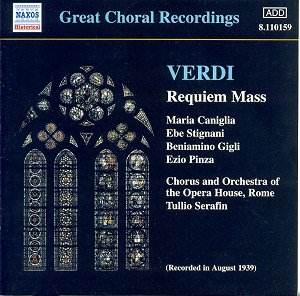This recording has some formidable rivals, and it must
immediately be said that anyone looking for a convincing performance
of Verdiís masterpiece would do well to avoid it, even at bargain price.
It has sometimes been suggested that the Requiem is "too operatic"
to be successful as a sacred work. Whether that is a fair criticism
may depend on particular performances, but under Serafin the choir,
orchestra and a starry line-up of soloists conspire to highlight its
florid aspects at the expense of the reflective, reverent qualities
of Verdiís rich and colourful score. Brisk tempi may work well in such
large set-pieces as the Dies Irae, but in this reading an immense
amount of important detail is lost due to driving speeds that amount
to sheer negligence. The quirky nature of the original 1939 analogue
recording also makes for some uncomfortable moments, added to which
there is a serious lack of balance between choir, orchestra and soloists,
a boxy acoustic and, in places, noticeable inaccuracies of pitch.
Compensation for such worrisome matters is sorely needed,
and comes mainly after a helter-skelter Rex tremendae in sections
where the soloists are allowed to have more of their own way with the
words. Gigliís voice is at its mature best. It shines in the
Ingemisco, and later reaches lyrical heights in the affecting
Hostias. Pinzaís expressive and sensitive control is impressive
throughout, especially in the Confutatis and, having fought off
an over-excited choir, all the soloists give of their best in the Lacrymosa.
Yet surely Verdi would not have wanted to hear his masterpiece performed
under a conductor who seems to have forgotten that it is intended for
a cathedral, not an opera house.
Much-admired analogue recordings of the Requiem by
Toscanini and Giulini can occasionally be found, and are well worth
acquiring. However my vote goes to a thrilling account that combines
subtlety and drama in a beautifully judged (through undated) performance
on Deccaís 1995 remastering in a two-CD set (444 833-2), with Leontyne
Price, Rosalind Elias, Jussi Björling and Giorgio Tozzi, the choir
of the Musikfreunde, Vienna, and the Vienna Philharmonic Orchestra conducted
by Fritz Reiner. This was recorded in 1959. For some Reinerís tempi
may seem a little too leisurely (a total playing time which makes
it a surprising 22.41 slower than Serafinís). Nevertheless this treasured
interpretation shows clearly how much is lost by the rashly fast speeds
encouraged by Serafin. A worthwhile bonus on the Decca disc is Verdiís
rarely-heard Four Sacred Pieces with Yvonne Minton, the Los Angeles
Master Chorale and LA Symphony Orchestra conducted by Zubin Mehta.
Roy Brewer
Reiner's treasured 1959 Vienna interpretation shows
clearly how much is lost by the rashly fast speeds encouraged by Serafin.
Surely Verdi would not have wanted to hear his masterpiece performed
under a conductor who seems to have forgotten that it is intended for
a cathedral, not an opera house.

![]() Maria Caniglia (soprano)
Maria Caniglia (soprano)
![]() NAXOS 8.110159 [72.47]
NAXOS 8.110159 [72.47]